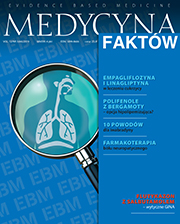Fexofenadine – the facts speak for themselves Review article
Main Article Content
Abstract
Fexofenadine is a modern second-generation antihistamine. It is an oral, long-acting bipolar, non-reverse, inverse agonist of the H1 receptor. Its important feature is the lack of influence on cognitive functions and sedative action due to the impenetrable blood–brain barrier and anticholinergic effects. Fexofenadine has not been shown to interact with food, alcohol and other medicines. There were no effects on the ECG record and the risk of cardiovascular complications in adults and children. Its pharmacological properties mean that there is no need to modify the dose in the elderly, patients with liver or kidney impairment.
Article Details
How to Cite
Sybilski , A. J. (2019). Fexofenadine – the facts speak for themselves. Medycyna Faktow (J EBM), 12(3(44), 238-241. https://doi.org/10.24292/01.MF.0319.8
Issue
Section
Articles
Copyright © by Medical Education. All rights reserved.
References
1. Devillier P., Roche N., Faisy C.: Clinical pharmacokinetics and pharmacodynamics of desloratadine, fexofenadine and levocetirizine: A comparative review. Clin. Pharmacokinet. 2008; 47: 217-230.
2. Fitzsimons R., van der Poel L.A., Thornhill W. et al.: Antihistamine use in children. Arch. Dis. Child Educ. Pract. Ed. 2015; 100: 122-131.
3. Russell T., Stoltz M., Weir S.: Pharmacokinetics, pharmacodynamics, and tolerance of single- and multiple-dose fexofenadine hydrochloride in healthy male volunteers. Clin. Pharmacol. Ther. 1998; 64: 612-621.
4. Church M.K., Church D.S.: Pharmacology of antihistamines. Indian J. Dermatol. 2013; 58: 219-224.
5. Paśko P., Rodacki T., Domagała-Rodacka R. et al.: Second generation H1 – antihistamines interaction with food and alcohol-A systematic review. Biomed. Pharmacother. 2017; 93: 27-39.
6. Dávila I., del Cuvillo A., Mullol J. et al.: Use of second generation H1 antihistamines in special situations. J. Investig. Allergol. Clin. Immunol. 2013; 23(supl. 1): 1-16.
7. Welzel T., Ziesenitz V.C., Seitz S. et al.: Management of anaphylaxis and allergies in patients with long QT syndrome: A review of the current evidence. Ann. Allergy Asthma Immunol. 2018; 121: 545-551.
8. Mansfield L.E.: Fexofenadine in pediatrics: oral tablet and suspension formulations. Expert. Opin. Pharmacother. 2008; 9: 329-337.
9. Mason J., Reynolds R., Rao N.: The systemic safety of fexofenadine HCl. Clin. Exp. Allergy 1999; 29(supl. 3): 163-170.
10. Lippert C., Rao N., Eller M., Weir S.: Pharmacokinetics of fexofenadine in liver diseased patients. Pharm. Res. 1996; 13(supl.): 431.
2. Fitzsimons R., van der Poel L.A., Thornhill W. et al.: Antihistamine use in children. Arch. Dis. Child Educ. Pract. Ed. 2015; 100: 122-131.
3. Russell T., Stoltz M., Weir S.: Pharmacokinetics, pharmacodynamics, and tolerance of single- and multiple-dose fexofenadine hydrochloride in healthy male volunteers. Clin. Pharmacol. Ther. 1998; 64: 612-621.
4. Church M.K., Church D.S.: Pharmacology of antihistamines. Indian J. Dermatol. 2013; 58: 219-224.
5. Paśko P., Rodacki T., Domagała-Rodacka R. et al.: Second generation H1 – antihistamines interaction with food and alcohol-A systematic review. Biomed. Pharmacother. 2017; 93: 27-39.
6. Dávila I., del Cuvillo A., Mullol J. et al.: Use of second generation H1 antihistamines in special situations. J. Investig. Allergol. Clin. Immunol. 2013; 23(supl. 1): 1-16.
7. Welzel T., Ziesenitz V.C., Seitz S. et al.: Management of anaphylaxis and allergies in patients with long QT syndrome: A review of the current evidence. Ann. Allergy Asthma Immunol. 2018; 121: 545-551.
8. Mansfield L.E.: Fexofenadine in pediatrics: oral tablet and suspension formulations. Expert. Opin. Pharmacother. 2008; 9: 329-337.
9. Mason J., Reynolds R., Rao N.: The systemic safety of fexofenadine HCl. Clin. Exp. Allergy 1999; 29(supl. 3): 163-170.
10. Lippert C., Rao N., Eller M., Weir S.: Pharmacokinetics of fexofenadine in liver diseased patients. Pharm. Res. 1996; 13(supl.): 431.

